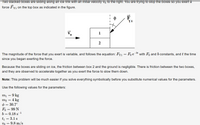Question
I am unsure how to really start this problem. How would I set this up?

Transcribed Image Text:Acceleration
Determine the magnitude of the common acceleration of the two boxes a time ti after you begin exerting the force. Assume that
ti is before the two boxes stop.
Click here for a hint
a(tı) = 23 m/s^2
Think carefully about which forces actually act on each object. The force you apply is only acting on block 1. Then, think about
what kind of force enables the blocks to have a common acceleration. You will need an FBD of each block.

Transcribed Image Text:Two stacked boxes are sliding along an ice rink with an initial velocity vo to the right. You are trying to stop the boxes so you exert a
force Fy1 on the top box as indicated in the figure.
F
Y1
1
2
The magnitude of the force that you exert is variable, and follows the equation: Fy1 = Fo e
- bt
with Fo and b constants, and t the time
since you began exerting the force.
Because the boxes are sliding on ice, the friction between box 2 and the ground is negligible. There is friction between the two boxes,
and they are observed to accelerate together as you exert the force to slow them down.
Note: This problem will be much easier if you solve everything symbolically before you substitute numerical values for the parameters.
Use the following values for the parameters:
mị = 9 kg
то — 4 kg
0 = 30.7°
Fo = 99 N
b = 0.18 s-1
t1 = 3.1 s
vg = 9.8 m/s
Expert Solution
This question has been solved!
Explore an expertly crafted, step-by-step solution for a thorough understanding of key concepts.
This is a popular solution
Trending nowThis is a popular solution!
Step by stepSolved in 4 steps with 1 images

Knowledge Booster
Similar questions
- I'm very confused on how to do this problem.arrow_forwardPlease help me in a step by step solution for problem #10?arrow_forwardA team of astronauts is on a mission to land on and explore a large asteroid. In addition to collecting samples and performing experiments, one of their tasks is to demonstrate the concept of the escape speed by throwing rocks straight up at various initial speeds. With what minimum initial speed ?escvesc will the rocks need to be thrown in order for them never to "fall" back to the asteroid? Assume that the asteroid is approximately spherical, with an average density ?=4.10×106 g/m3ρ=4.10×106 g/m3 and volume ?=1.25×1012 m3V=1.25×1012 m3 . Recall that the universal gravitational constant is ?=6.67×10−11 N·m2/kg2G=6.67×10−11 N·m2/kg2 .arrow_forward
- I need help figuring out if this is a correct solution or not and why Thank youarrow_forwardI have tried this problem a few time how do I solve it?arrow_forwardJupiter's moon Io has active volcanoes (in fact, it is the most volcanically active body in the solar system) that eject material as high as 500 km (or even higher) above the surface. Io has a mass of 8.93×1022kg8.93×1022kg and a radius of 1821 km. How high would this material go on earth if it were ejected with the same speed as on Io? (RE = 6370 km, mE=5.96×1024kg)arrow_forward
- I am a bit confused by how you did the first one, and what the answer is.arrow_forwardI don’t know where to start with this problem.arrow_forwardYour help working through this problem will be a greater learning experience than I've had in class this semester. I have so little idea of how to begin this.arrow_forward
- How do I solve this problem properly in a step by step solution?arrow_forwardhow would i "draw a tip-to-tail vector addition diagram that relates together vi, vf, and delta v"?? pls help ASAP!arrow_forwardI have been working on this problem for a while what is the correct way to solve this?arrow_forward
arrow_back_ios
SEE MORE QUESTIONS
arrow_forward_ios